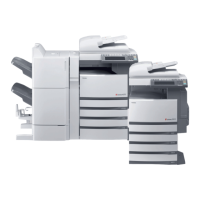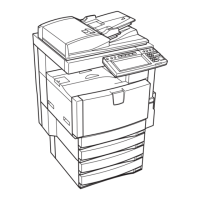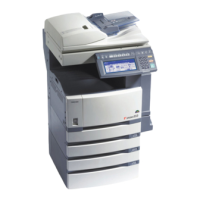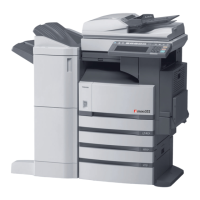What to do if my Toshiba All in One Printer says 'Door open'?
- CChristopher LopezAug 28, 2025
If your Toshiba All in One Printer shows a 'Door open' error, make sure to firmly close the open door.

What to do if my Toshiba All in One Printer says 'Door open'?
If your Toshiba All in One Printer shows a 'Door open' error, make sure to firmly close the open door.
How to clear original jam in Toshiba All in One Printer?
If your Toshiba All in One Printer displays an 'Original jam' error, the solution is to clear the jammed original.
How to fix paper jam in Toshiba All in One Printer?
If your Toshiba All in One Printer displays a 'Paper jam' error, the solution is to clear the jammed printing paper.
What causes signal error on Toshiba All in One Printer?
If your Toshiba All in One Printer displays 'Signal Error or Line Condition Error', retry communications. Frequent failures may indicate a phone line problem. If possible, move the unit to another line and try your communications again.
How to resolve server time time-out error on Toshiba All in One Printer?
If your Toshiba All in One Printer displays 'Server time time-out error', check if the SMTP server is operating properly.
How to resolve internet fax transmission failure when processing fax job on Toshiba All in One Printer?
If your Toshiba All in One Printer displays 'Internet Fax transmission failure when processing Fax job received', confirm the 'Received Fax Forward' setting.
How to fix PM size error on Toshiba All in One Printer?
If your Toshiba All in One Printer displays 'PM size error', 1200 dpi print jobs cannot be printed without the optional expansion memory. Send a print job with a 600 dpi setting.
What to do if system access abnormality on Toshiba All in One Printer?
If your Toshiba All in One Printer displays 'System access abnormality', turn the power OFF and then back ON. Perform the job in error again. If the error still occurs, contact your service representative.
What to do if job reservation is full on Toshiba All in One Printer?
If the job reservation is full on your Toshiba All in One Printer, it is because the number of reserved jobs has exceeded 100. You can either wait for the job reservations to complete, or check the jobs and delete reserved jobs.
Why are black lines appearing on images from my Toshiba e-STUDIO3511?
If you observe black lines in the images sent from your Toshiba All in One Printer, clean the scanning area of the Reversing Automatic Document Feeder with a soft cloth.
| Print Speed (Black) | 35 ppm |
|---|---|
| Max Print Resolution | 2400 x 600 dpi |
| Max Copy Resolution | 600 x 600 dpi |
| Copy Resolution | 600 x 600 dpi |
| Fax Speed | 33.6 Kbps |
| Original Size | A3 |
| Duplex Printing | Yes |
| Functions | Copier, Printer, Scanner |
| Copy Speed | 35 ppm |
| Scan Resolution | 600 dpi |
| Connectivity | USB |
| Network Connectivity | Ethernet |
| Operating System Compatibility | Windows, Mac |
Precautions and procedures for safely installing or moving the equipment to prevent damage or injury.
Guidelines for using the departmental systems safely and effectively, including handling.
Safety precautions to follow when performing maintenance or inspection on the equipment.
Safety guidelines for handling consumables like toner cartridges and paper.
Details on toner quality, cost advantage, environmental harmony, and user-friendliness.
Information on ISO certifications and service support benefits for Toshiba products.
Safety guidelines for moving and installing the equipment, including power and ventilation.
Ensuring adequate space and proper environmental conditions for optimal operation.
Precautions during operation, including handling heat and potential hazards.
Careful handling of touch panels and power switch operations to prevent issues.
Safety warnings and precautions for maintenance and inspection procedures.
Safety guidelines for handling consumables like toner cartridges and paper.
Information on the copier's forgery prevention feature and responsible usage.
Guidelines for proper storage of color copies to prevent fading or damage.
Overview of main components, optional equipment, control panel, and touch panel.
Step-by-step instructions for powering the equipment on and off safely.
Procedure for activating the energy-saving mode to reduce power consumption.
Instructions on selecting and loading paper types, sizes, and handling special paper.
Guidance on placing originals on the glass or using the ADF for copying.
Step-by-step process for performing standard copying operations.
How to set up and use the Auto Job Start feature for preset copying jobs.
Procedure for interrupting a current copy job to perform another.
Methods for stopping an ongoing scanning or multi-copying operation.
Instructions for making copies using the bypass tray for special paper or sizes.
Options for selecting paper type and size, including APS and manual selection.
How to select between full color, black, and auto color copy modes.
Methods for reducing or enlarging documents during copying.
Options for sorting, stapling, booklet making, and hole punching copies.
Instructions for 1-sided, 2-sided, and book-type copying.
How to select the optimal image mode based on the original type.
Adjusting image density using automatic or manual modes for optimal output.
Adjusting color balance by modifying toner amounts for Y, M, C, and K.
Adjusting color balance by changing the strength of Red, Green, and Blue.
Quickly adjust image quality to warm, cool, vivid, or clear.
Adjusting original background density or avoiding copying the back side.
Emphasizing letters and edges of images for clearer output.
Making copies with two colors from a colored original.
Creating binding margins by shifting the original image left or right.
Eliminating black stains along original edges by creating a white border.
Erasing the shadow in the center of a book original.
Copying facing pages onto separate sheets or duplexing them.
Reducing and copying multiple originals onto a single sheet.
Sorting originals for folding and binding like magazines or booklets.
Trimming or masking specific areas of an original for copying.
Creating copies with images completely reversed (right and left).
Setting different reproduction ratios for X (horizontal) and Y (vertical) directions.
Adding a top and/or back cover sheet to sets of copies.
Inserting special sheets at specified pages within a set of copies.
Adding the time and date of scanning to copies.
Adding page numbers at specified positions on copies.
Adjusting copy image direction for specific binding orientations.
Rotating duplex copy images for specific binding orientations.
Selecting continuous or single feed modes for the ADF.
Storing copied original data into the e-Filing system for later retrieval.
Sending and storing copied original data to hard disk or PC.
Interface for entering text, including file names and addresses.
Configuring scan settings like resolution, color mode, and file format.
Scanning documents directly into the e-Filing system.
Scanning documents and saving them to a file on the network or local storage.
Scanning documents and sending them as email attachments.
Explanation of Internet Fax functionality and transmission methods.
Procedures and settings for sending documents via Internet Fax.
Methods and modes for receiving Internet Fax transmissions.
Displaying and managing printing, fax, and scanning jobs in the waiting status.
Viewing, deleting, pausing, and moving print jobs.
Performing proof prints and managing print job settings.
Printing documents securely by entering a password.
Managing copier usage and restrictions using department codes.
Checking the status of fax and internet fax jobs.
Checking the status of scan jobs.
Viewing print, send/receive fax, and scan logs for confirmation.
Registering recipients from send/receive or scan logs into the address book.
Printing the send/receive log list for fax transmissions.
Displaying drawer size and active drawer status during printing.
List of error codes, their causes, and corrective actions for fax and scan.
Introduction to e-Filing, its components, and basic operations.
Steps for creating and configuring user boxes for document storage.
Modifying registered box names, user names, and passwords.
Procedure for deleting unnecessary user boxes and their contents.
Printing documents stored in the e-Filing system, including test printing.
Explanation of templates for saving and recalling function combinations.
Steps to recall public or user group templates for copy, scan, or fax settings.
Process for registering function combinations as public or user templates.
Modifying template or user group data, including names and passwords.
Procedures for deleting unnecessary templates or user groups.
Explanation of various blinking graphic symbols on the touch panel.
Guidance on symbols indicating paper misfeeds and how to clear them.
Instructions for replacing toner cartridges when prompted by the symbol.
Guidance on replacing the toner bag when it becomes full.
Procedures for clearing paper misfeeds in various parts of the equipment.
Instructions for adding staples to the finisher cartridges.
Steps to remove jammed staples from the finisher.
Procedure for disposing of punched paper bits from the hole punch unit.
Information on call service symbols and periodic maintenance messages.
Daily checks for power status and weekly cleaning recommendations.
Basic troubleshooting steps for common equipment issues.
Checks for power cord insertion and front cover closure.
Troubleshooting when the display does not change or respond.
Resolving issues with image density being too low or too high.
Troubleshooting for stained or blurred images.
Resolving issues with missing images or non-functional settings.
Troubleshooting when the desired colors do not appear correctly.
Detailed technical specifications of the e-STUDIO3511/4511 models.
Technical details for optional accessories like feeders and finishers.
List of items included in the product packaging.
Matrix showing combinable copying functions.
Matrix detailing combinations for image quality settings.











